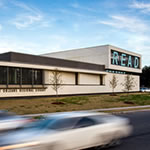This article is an excerpt from New Orleans: Structure, Community, City. Find it at the Greenbuild Bookstore or contact Jen Illescas at [email protected]/magazine.
–
New Orleans was underwater. Up to 15 feet of it filled some neighborhoods, and 80 percent of the city was flooded. Damage from Hurricane Katrina was extensive, and when it came time to rebuild, it was hard to find a place to start. The problem of reconstruction became a catch-22: should residents wait for businesses and services to return before they did? But how could the city attract those things without people to use them? In the end, it was a public good, not a private one, that took first priority. The city rallied around its libraries as one of the first major reconstruction projects throughout the landscape.
Of the 14 libraries in the New Orleans public system, five were either destroyed or left uninhabitable after the floodwaters receded. Libraries became a priority through the “New Orleans Principles,” a set of guidelines developed by local and national experts convened by the USGBC that called for resilient and sustainable building and the reconstruction of “places of refuge” as a means for creating a better city post-Katrina.
New Orleans’ dedication to its public library system did not go unnoticed elsewhere. The American Library Association held its major convention there in 2011, a year before many of the new libraries opened, and reported signs of major rehabilitation efforts. “It’s been a long struggle, but evidence of recovery is everywhere,” an article titled “New Orleans on the Mend” reported in American Libraries magazine. The four libraries detailed here were built to meet LEED standards and serve as anchors in their communities. The new libraries have similar designs and materials, using white stucco and gray brick, but each library was modified to fit in neatly with its neighborhood.
Robert E. Smith Library
The two-story building located in New Orleans’ Lakeview neighborhood includes picture windows that filter in natural light throughout the building with some that look out to an interior courtyard. With children’s collections and technology centers, the building consists of two “U”-shaped blocks that cradle the internal courtyard on a raised plaza. The shape gives visitors the impression that they’re not far from the outdoors at any point in the library, and the blue and green walls of the interior continue to bring the colors of nature inside.

Robert E. Smith Library offers plenty of bike parking to accommodate the growing cycling community in New Orleans.
East New Orleans Regional Library
The East New Orleans Regional Library, with the word “READ” in bold blue letters plastered across high picture windows, was one of the first new libraries to open. The two-story facility has a meeting room that can accommodate 300 people, a technology center, a front courtyard, and a walking path connecting it to Joe W. Brown Park. The library has spaces for all ages with a children’s room, a teen area, and an adult learning center.

Connected to a public park and featuring its own courtyard in front, the East New Orleans Regional Library building has an eco-friendly white roof, exterior sunscreens, and low-E tinted windows.
Norman Mayer Library
Housing a meeting room, approximately 25,000 circulating items, 19 public computers, free WiFi, and more than 2,000 DVDs, the Gentilly branch of New Orleans’ library system meets diverse needs. The room housing the teen collection overlooks Gentilly Boulevard, and the main entrance stair at the corner of Gentilly and Norman Mayer draws in pedestrians from the busy corridor. Slated as a music center, the library features an audio recording collection and several music-listening stations. To reduce building energy and water use, the library employs smart resource-reduction strategies and passive cooling.

Norman Mayer caters to the public with bicycle storage and access to public transportation.
Algiers Regional Branch Library
Two wings replace the old one-story building that used to stand on Holiday Drive. Outdoor seating, commercial space, and a meeting room for 300 people with an adjoining kitchenette show that this library is about far more than books. The building features exposed ceilings defined by black ductwork, expansive windows keep the space naturally lit, and the adult and children’s collections are separated by glass that keeps the open floor plan intact.

Algiers Regional is notable for its large cavity of open space just past the entrance. A high ceiling and open floor plan allow easy wayfinding and provide visitors ample walking room.
–
This article is an excerpt from New Orleans: Structure, Community, City. Find it at the Greenbuild Bookstore or contact Jen Illescas at [email protected]/magazine.

